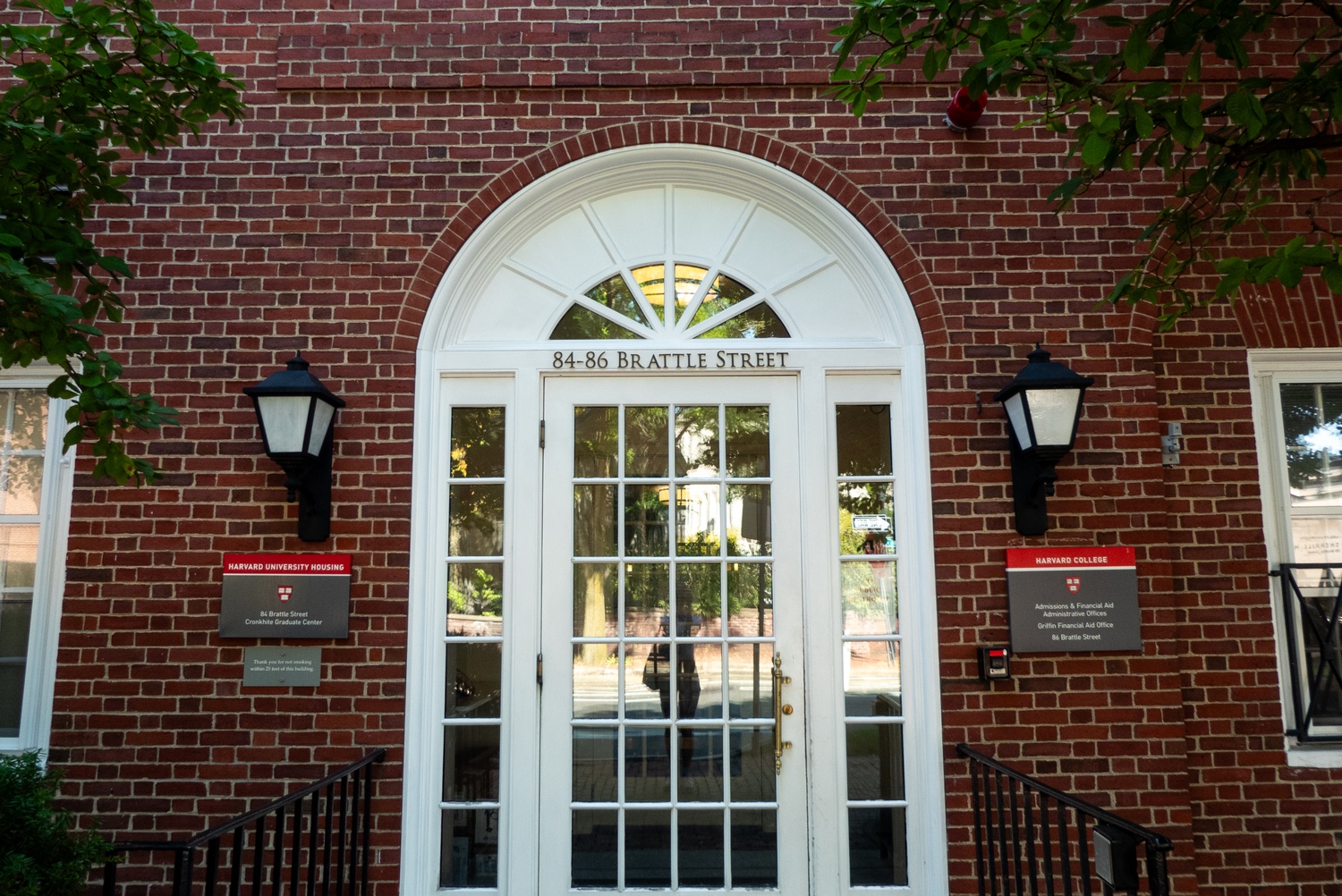
News
Summers Will Not Finish Semester of Teaching as Harvard Investigates Epstein Ties

News
Harvard College Students Report Favoring Divestment from Israel in HUA Survey

News
‘He Should Resign’: Harvard Undergrads Take Hard Line Against Summers Over Epstein Scandal

News
Harvard To Launch New Investigation Into Epstein’s Ties to Summers, Other University Affiliates

News
Harvard Students To Vote on Divestment From Israel in Inaugural HUA Election Survey
Early Data Shows 85% of Admits Plan to Join Harvard’s Class of 2029, Despite Federal Attacks and Funding Cuts

Updated August 16, 2025, at 5:11 p.m.
Roughly 85 percent of admits accepted their offers to enroll in Harvard College’s Class of 2029, the College’s admissions office revealed in a Saturday meeting with students that included an extensive presentation of preliminary statistics on Harvard’s incoming class.
The data, which was dated May 27, provided an early snapshot of the students who will arrive at Harvard this fall. It showed that the proportion of international freshmen was on track to remain roughly steady, despite the Trump administration’s attacks — but did not include the College’s acceptance rate or information on the race of matriculating students.
Those numbers remain hotly anticipated as the University reckons with the Supreme Court’s 2023 ruling in Students for Fair Admissions v. Harvard, which overturned the College’s use of race-conscious admissions, and accusations from the Trump administration that it illegally favors Black and Latino students.
In the past, Harvard has released data about its admitted class alongside its admissions decisions. But, beginning with the Class of 2028, Harvard has delayed the publication of race and ethnicity data. In October, Harvard announced that it would break nearly 70 years of precedent and withhold demographic information on the Class of 2029 until it must be reported to the Department of Education this fall.
The information shared by College officials during the Saturday meeting, which was a training session for students who lead pre-orientation programs, was marked “Confidential/Not for Distribution.” It represents the first look at the incoming class — the second to be admitted since the ruling in SFFA and since the University overhauled its application questions.
As of May, 1,654 students had matriculated to the Class of 2029 — representing a slight rise in Harvard’s yield rate despite the Trump administration’s attacks on international students and federal funding cuts that University officials estimate could cost $1 billion annually.
But the data may not capture changes that took place over the summer, especially as President Donald Trump’s attacks on international students escalated. Harvard allowed international students to accept offers at multiple universities and continued waitlist acceptances past the usual June 30 deadline.
Harvard College admissions director Joy St. John said at the meeting that the College had admitted roughly 25 to 30 additional students this year because of concerns that international students would be unable to obtain visas or enter the U.S.
As of May, St. John said, 15.8 percent of enrolled students were international — in line with international student enrollment in previous classes, which has hovered between 15 and 18 percent.
After this article’s publication, Faculty of Arts and Sciences spokesperson James M. Chisholm disputed the information presented by St. John at the meeting, writing that it “does not reflect accurate data for the Class of 2029. Official statistics will be released later in the fall.”
Women continue to make up a slight majority of the enrolled class at 52 percent. Every freshman class since the Class of 2024 has been majority female, but this year’s data represents a slight decline that has continued since the Class of 2026.
Roughly 21 percent of the class are first-generation college students, and 24 percent are eligible for federal Pell grants. More than half of the class — 54 percent — will receive institutional grant aid, and 24 percent will pay nothing to attend.
Harvard has repeatedly expanded its financial aid program in recent years and announced in March that attending the College would be free for students whose families make $100,000 or less.
The College continues to enroll a high percentage of students from the East Coast: 20 percent of the Class of 2029 hails from the mid-Atlantic, while 18 percent come from New England, 16 percent from the South, 13 percent from Pacific states, 3 percent from Mountain states, and 12 percent from the Midwest. The overall proportion of U.S. students in the class is comparable with that of prior classes.
A total of 17 veterans are also part of the class. The majority served in the Army, but the Air Force, Navy, and Marine Corps were also represented.
Among incoming students, 34.6 percent reported intending to concentrate in a field in the social sciences, 25.5 percent in engineering, 26.6 in the natural sciences, and 11.7 percent in the humanities.
Harvard’s admissions policies have been subject to intense national debate since even before SFFA, an anti-affirmative action group, first sued the University in 2014. The Trump administration has now rolled out an expansive — and legally controversial — interpretation of the SFFA decision that would bring efforts to recruit a diverse class under further scrutiny.
Federal officials have accused universities of using recruiting efforts, as well as application questions about diversity or overcoming obstacles, to circumvent limits on considering race in admissions.
Some of that ire has been targeted at Harvard. In April, the White House demanded that Harvard adopt “merit-based admissions policies” and “cease all preferences based on race” — or lose access to its federal funding.
The government paused more than $2.7 billion in grants and contracts after Harvard rejected the demands, which University President Alan M. Garber ’76 labeled coercive and beyond federal authority.
International students have also been a focus of the Trump administration’s efforts to overhaul college admissions. The April demands asked Harvard to screen out international applicants who are “hostile to the American values and institutions inscribed in the U.S. Constitution and Declaration of Independence.” And federal officials have since stepped up vetting of international students’ online profiles, a measure they claim is designed to weed out antisemitism.
The Department of Homeland Security made two attempts to revoke Harvard’s authorization to host international students, one of which is ongoing, and a June 4 presidential proclamation barred foreign students from entering the U.S. to attend Harvard.
Though the administration’s initial efforts have been temporarily blocked in court, the DHS has continued to demand information from Harvard on international students’ disciplinary records and participation in protests. It has also required Harvard to turn over the forms authorizing its employees to work in the U.S.
The Trump administration has not directly asked universities to reduce the fraction of Black, Latino, or international students that they enroll — but repeated demands for “transparency” indicate that federal officials may not be satisfied unless they see a change in the profile of Harvard’s incoming students.
When the White House struck a deal in July to return Columbia University’s frozen federal funding, the agreement required Columbia to “undertake a comprehensive review of its international admissions processes and policies” and “take steps to decrease financial dependence on international student enrollment.”
And earlier this month, Trump released a memorandum that will now require Harvard — and all other American universities — to submit data showing that they do not consider race in admissions.
The memo asks the Department of Education to “expand the scope of required reporting to provide adequate transparency into admissions, as determined by the Secretary of Education, consistent with applicable law” for the 2025-26 academic year.
—Staff writer Samuel A. Church can be reached at samuel.church@thecrimson.com. Follow him on X @samuelachurch.
—Staff writer Cam N. Srivastava can be reached at cam.srivastava@thecrimson.com. Follow him on X @camsrivastava.
Want to keep up with breaking news? Subscribe to our email newsletter.
